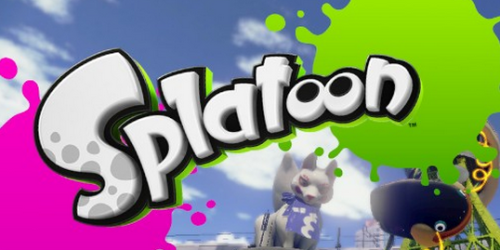
Splatoon review
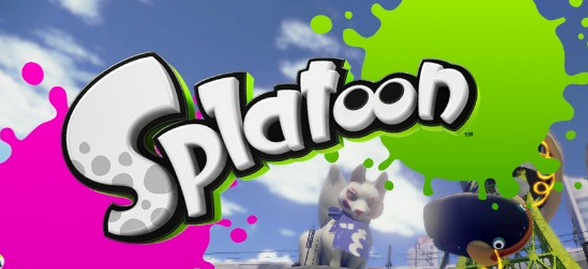
Nintendo has released a multiplayer online shooter.
If that sentence strikes you with an overwhelming sensation of vexation and befuddlement, don’t be alarmed. You don’t need to dial 911. This is simply your firm grasp of the current gaming industry being uprooted by the reality that Nintendo has in fact released an online shooter for Wii U. Pop a few aspirin. You’ll feel better.
Nintendo, a game company known to the mainstream more for friendly, family-appropriate platformers, party romps, and light adventure/puzzle games has brazenly pushed their familiar bounds further into the dimension of internet-based video games. This is a realm most notably filled with rampant harassment of all imaginable kinds. Disgusting, spiteful profanity and racist affronts to mankind are, these days, par for the course in online chat rooms for both console and PC-based multiplayer shooters. And Nintendo wants to make one of these?
Splatoon is Nintendo’s recent foray into this realm. Released right at the end of May 2015, Splatoon is a team-based multiplayer third-person shooter on the Wii U produced and developed by Nintendo proper. That makes it, to my knowledge, the first new property created in-house by Ninty since Pikmin in 2001. Regardless, this is a new IP that’s been receiving a lot of attention lately. Let’s look closer and find out why.
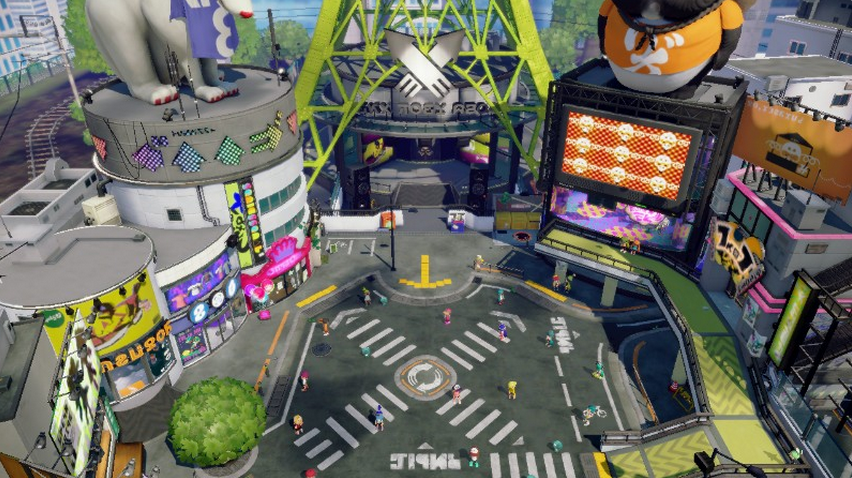
The world of Splatoon is populated by anthropomorphic sea creatures of all shapes and colors. The player controls a profile-specific Inkling, a little boy or girl of human form who can transform at will into a cartoon squid. These Inklings carry various weapons with them into battle, including small ink RPG’s, ink sniper rifles, ink rocket launchers, ink rollers, ink brushes, ink bombs, and lots of other shooter game fare that, as you will quickly discover, spread ink instead of death. Headshots and killstreaks aren’t the point of Splatoon. Ink is.
Inklings in two teams of four are set loose in arenas where the goal of each three minute match is to cover the most ground with their color of ink by launching it from their weapons. With such a clear objective, the player will immediately start finding their preferred method of helping their team win. Do you like to push forward and cover the middle ground by fighting off enemies? Do you like to hang back and fill in the gaps near your spawn? Do you like to take the side road and splat up the alternate paths to gain coverage? It’s entirely up to you.
The maps themselves are the Goldilocks of map sizes. Not too big that you could get lost in them; not too small that you’re running into other players all the time. With high ground and low ground aplenty, and numerous paths to take in these symmetric maps, players have plenty of room to move around. On foot, Inklings move at a basic pace. In squid form, players can move quickly through their own color of ink and recover ammunition (and stay still to hide and ambush unsuspecting enemies). In the ink of the other team, Inklings drag their feet, leaving them sitting ducks. The floor isn’t the only surface for movement, mind you. Spraying the walls with ink will allow squids to travel up and across as they please. Gaining some altitude can be the key to gaining territory.
To keep an eye on your team’s progress throughout the match, the Wii U Game Pad screen provides a convenient map of real time ink spread. At any time, players can tap the location of team mates to Super Jump over to them. Use this upon respawn to quickly jump back into the action, instead of having to waste time swimming across the map every time you die.
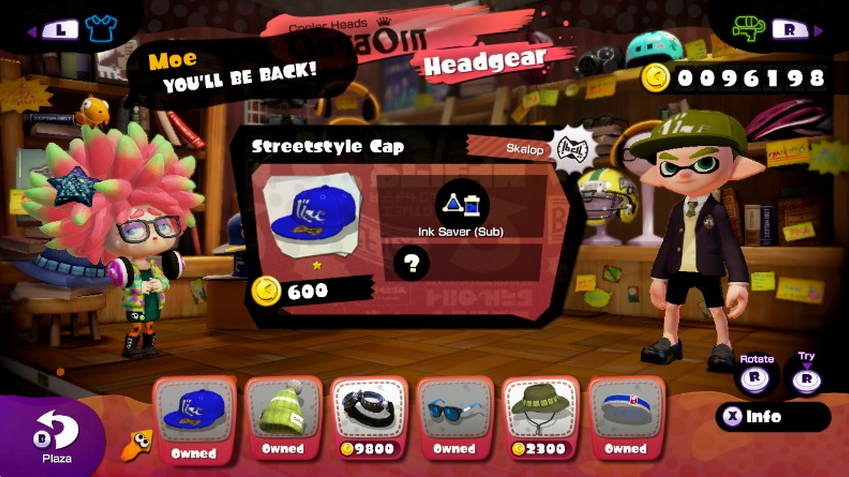
Each player possesses one primary weapon (your main inking gun or paint spreader), one secondary weapon (bombs or sprinklers), and one Special weapon (bazookas, echolocators, or a Kraken transformation). Most of these weapon function in mostly the same way, save for the brushes and rollers. Brushes and rollers are more powerful in close quarters, allowing for wide ink coverage and ideal flanking situations. All these weapons are powerful, yet balanced. Each weapon will vary by load out, which can be done in Inkopolis with goods bought from the local marine life. You can buy everything from a .52 Gallon ink launcher to an NES Zapper.
In Booyah Base, merchants will sell you unique footwear, headwear, and torsowear. Each item comes with at least one stat boost of some kind. Be it extra defense, quicker swimming speed, or shorter respawn, acquired accessories can be leveled up by gaining EXP in online battles. In fact, the ability to carry many weapons is won through leveling up one’s Inkling online. Players can face off against other Splatoon owners on the internet through standard Regular Battles and more high-level Ranked Matches. The default battle mode is Turf War, in which player must cover as much of the map as possible in their color of ink. There is also Tower Control, in which Inklings take control of a moving tower and hold it until victory. Nintendo has mentioned more modes being available in the future.
When it comes to online play, Splatoon is as free of bugs as one can reasonably expect. For the Wii U’s free online functionality, online four-on-four matches run pretty darn well, especially against Japanese players in another hemisphere. There’s some delay here and there, but otherwise my experience online has only involved two dropped matches so far. Finding games of eight players rarely takes long (since the game just came out). Although it is a little strange that you can’t jump out of the online mode until a match ends. Also strange is the fact that you can’t swap equipment and gear without leaving a lobby.
A third strange detail is the map selection. As of launch, the seven available maps (Arowana Mall, Urchin Underpass, Port Mackerel, Blackbelly Skatepark, Kelp Dome, Walleye Warehouse, and Saltspray Rig) were as diverse as they were a pleasure to play. Seven is a decent number for the game’s release window. It’s just that online lobbies only alternate between two of them. You’d have to disconnect and jump back on later to get much variety. But anyone looking for variety from hectic online mayhem will find satisfaction in Splatoon’s single player campaign.
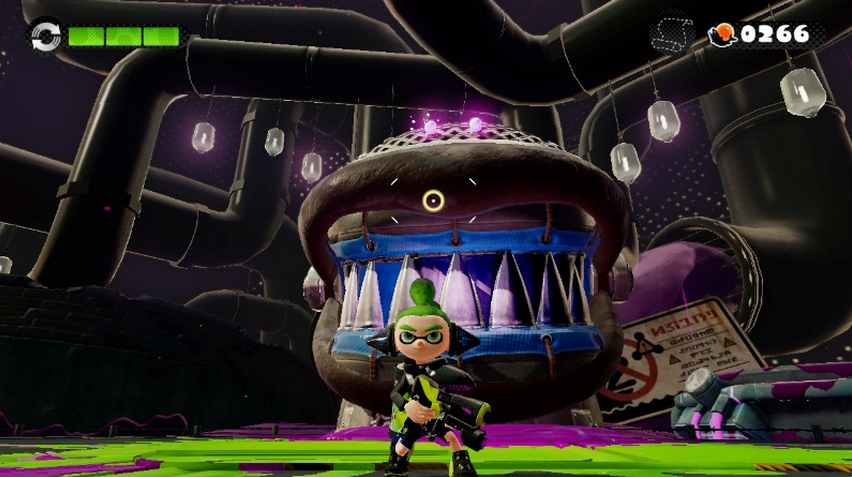
Splatoon’s single player mode (titled Hero Mode) takes place in Octo Valley, where the eccentric Cap’n Cuttlefish has assumed the role of the sole, apparent resistance against the invading Octarians. Evil octopi threaten to take control of Inkopolis, so the Cap sends the player into a series of missions that involve claiming platforms from Octarians and advancing to recover a Zapfish. Each mission launches your Inkling from platform to platform with a unique challenge on each one, reminding me strongly of Super Mario Galaxy galaxies. A Sunken Scroll is hidden in each stage as a nifty extra challenge for the completionists out there. It’s all very Nintendo from top to bottom.
The single player ended up surprising me the most here. I thought it would act as a simple training mode for the online, but no. The offline campaign stands as its own as engaging and memorable. The final boss is among the most exhilarating single enemy battles in recent memory. This mode also provides the player with extra weapons that can be bought in Booyah Base in Inkopolis. Another way of acquiring content in Splatoon is through everyone’s favorite thing that Nintendo has given us lately…
Amiibo! yay video games so much fun…
I consider myself a lucky son of a gun that I even found some amiibo for Splatoon. I didn’t have to wait outside a Walmart for seven hours like most people. I didn’t even have to hijack a truck! I just walked into my Gamestop, which had, according to the saleswoman, received only one set of the Inkling Girl, Inkling Boy, and Squid. Anyway, in Splatoon, these figurines unlock variations of Octo Valley missions in which the player must use different weapons loadouts to complete the same goal. The reward is a crap load of in-game currency and unique mini-games and accessories.
As far as DLC goes in this day and age, this is far from over-priced and further from the outright theft other companies will pull on gamers. Still, I am concerned about the fact that the content that I unlocked with my amiibo was already on the game disc. Sure, it’s just slightly different missions and equipment that isn’t functionally better than anything available to those who didn’t or couldn’t purchase amiibo. Is this Capcom-level on-disc DLC or just simple incentives for buying collectible plastic toys? I’ll let you all decide.
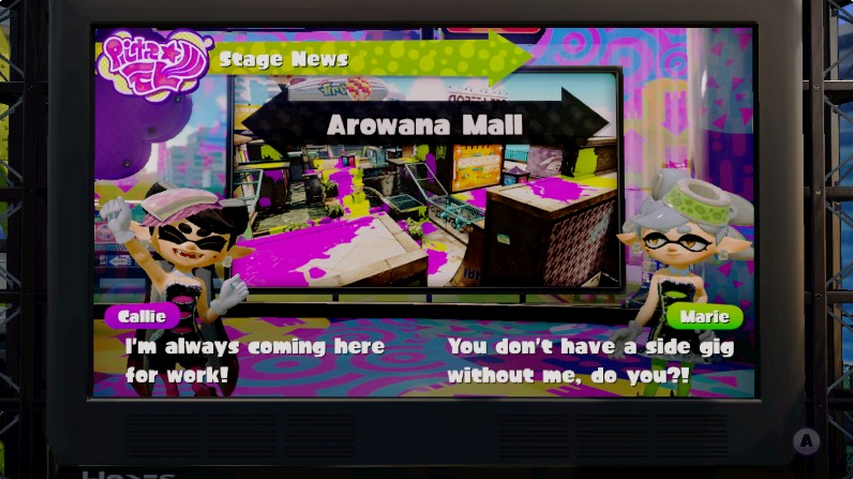
Being a modern Nintendo game, integration with Miiverse provides a level of community and social networking for people who care about that sort of thing. In the Inkopolis square, the Inklings of other players with whom you’ve played will be meandering around. You can give a Yeah! to their Miiverse posts and see what equipment they’ve been carrying. Those who don’t mind Spongebob memes and other pop culture references might even find some laughs here. I’m not saying I was surprised by the existence of jokes about sentient sea creatures in Miiverse. Just by the quantity.
There will also be occasional Splatfests hosted in Inkopolis. Splatfests are region-specific online tournaments in which all players joining will decide between two teams (rice vs. bread, rock vs. pop music, or cats vs. dogs) and battle online similarly to Conquests in Super Smash Bros. 4. Nintendo’s not in much of a hurry to start these. They’re probably too busy porting Mother 3 or something dumb like that.
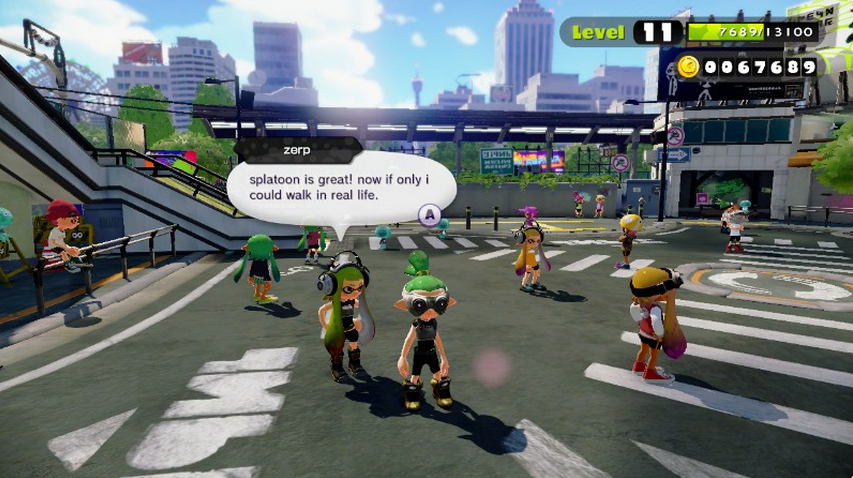
The visuals of Splatoon are colorful and vibrant in the same fashion as Mario Kart or Kirby. The environments are filled with structures mostly in gray, white, and browns, but given a sort of pop by a range of dark blue, light blue, green, pink, yellow, mint, and magenta representing the inks sprayed by Inklings in battle. Maps are these open-air urban/industrial areas like skate parks, oil rigs, and malls plastered with early-2000’s skateboard graffiti and logos in the Inkling language. The soundtrack fits the bill perfectly. The audio for the ink hitting surfaces and explosions really communicates when you’ve splatted an enemy or got splatted yourself. There’s a very satisfying rush that comes after a well-coordinated”plop-plop-plop-plop SPLAT!”
Splatoon is a fresh and fascinating take on the stifled prospect of online shooters. The idea of area control as the main focus of a shooter is hardly new. But to allow players to instantly see territory that they own and territory that they don’t by the placement of ink is something so simple yet so brilliant. Quality online connectivity and an impressive single player mode almost make me forget the unbearably intrusive Squid Sisters. Dialogue and menu text ripped right from 90’s Nickelodeon sitcoms fused with modern internet speak may seem stupid on the surface, but it’s the right kind of edge and wit that makes a world like Splatoon’s feel interesting to me. On top of it all, the single greatest cherry is the lack of online voice chat in game. Thank God Almighty we don’t have to be exposed to that sort of communication in our own living rooms. We should be on our knees thanking Nintendo that we don’t have to hear the same hateful, misogynistic, homophobic, toxic bile that fill the lobbies of other similar games.
Despite my concerns and complaints, Splatoon is an addicting endeavor to undertake. This is unlike any online shooter you’ve played before. The amount of customization and the opportunities for personalized strategy combined with a unique and lovable world make this a modern classic for the genre and for the Wii U. I can easily see Splatoon taking away from my normal Team Fortress 2 schedule. The game as it stands is already worth your cash. Further down the line, inevitable new modes, maps, weapons, and equipment are sure to keep players on these servers for a long time.
4 / 5
Funky Fresh
Categories: Reviews
0 Comments
This post has been left all alone with no comments. Don't leave it lonesome - give it some company with a comment.